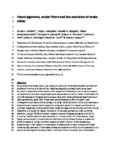Visual Pigments, Ocular Filters and the Evolution of Snake Vision
| dc.contributor.author | Simões, BF | |
| dc.contributor.author | Sampaio, FL | |
| dc.contributor.author | Douglas, RH | |
| dc.contributor.author | Kodandaramaiah, U | |
| dc.contributor.author | Casewell, NR | |
| dc.contributor.author | Harrison, RA | |
| dc.contributor.author | Hart, NS | |
| dc.contributor.author | Partridge, JC | |
| dc.contributor.author | Hunt, DM | |
| dc.contributor.author | Gower, DJ | |
| dc.date.accessioned | 2020-07-09T13:46:05Z | |
| dc.date.available | 2020-07-09T13:46:05Z | |
| dc.date.issued | 2016-10 | |
| dc.identifier.issn | 0737-4038 | |
| dc.identifier.issn | 1537-1719 | |
| dc.identifier.uri | http://hdl.handle.net/10026.1/15944 | |
| dc.description.abstract |
Much of what is known about the molecular evolution of vertebrate vision comes from studies of mammals, birds and fish. Reptiles (especially snakes) have barely been sampled in previous studies despite their exceptional diversity of retinal photoreceptor complements. Here, we analyze opsin gene sequences and ocular media transmission for up to 69 species to investigate snake visual evolution. Most snakes express three visual opsin genes (rh1, sws1, and lws). These opsin genes (especially rh1 and sws1) have undergone much evolutionary change, including modifications of amino acid residues at sites of known importance for spectral tuning, with several tuning site combinations unknown elsewhere among vertebrates. These changes are particularly common among dipsadine and colubrine "higher" snakes. All three opsin genes are inferred to be under purifying selection, though dN/dS varies with respect to some lineages, ecologies, and retinal anatomy. Positive selection was inferred at multiple sites in all three opsins, these being concentrated in transmembrane domains and thus likely to have a substantial effect on spectral tuning and other aspects of opsin function. Snake lenses vary substantially in their spectral transmission. Snakes active at night and some of those active by day have very transmissive lenses, whereas some primarily diurnal species cut out shorter wavelengths (including UVA). In terms of retinal anatomy, lens transmission, visual pigment spectral tuning and opsin gene evolution the visual system of snakes is exceptionally diverse compared with all other extant tetrapod orders. | |
| dc.format.extent | 2483-2495 | |
| dc.format.medium | Print-Electronic | |
| dc.language | en | |
| dc.language.iso | en | |
| dc.publisher | Oxford University Press (OUP) | |
| dc.subject | ocular media | |
| dc.subject | sensory evolution | |
| dc.subject | photoreception | |
| dc.subject | Serpentes | |
| dc.subject | spectral tuning | |
| dc.subject | vision | |
| dc.title | Visual Pigments, Ocular Filters and the Evolution of Snake Vision | |
| dc.type | journal-article | |
| dc.type | Journal Article | |
| dc.type | Research Support, Non-U.S. Gov't | |
| plymouth.author-url | https://www.webofscience.com/api/gateway?GWVersion=2&SrcApp=PARTNER_APP&SrcAuth=LinksAMR&KeyUT=WOS:000384205900001&DestLinkType=FullRecord&DestApp=ALL_WOS&UsrCustomerID=11bb513d99f797142bcfeffcc58ea008 | |
| plymouth.issue | 10 | |
| plymouth.volume | 33 | |
| plymouth.publication-status | Published | |
| plymouth.journal | Molecular Biology and Evolution | |
| dc.identifier.doi | 10.1093/molbev/msw148 | |
| plymouth.organisational-group | /Plymouth | |
| plymouth.organisational-group | /Plymouth/Faculty of Science and Engineering | |
| plymouth.organisational-group | /Plymouth/Faculty of Science and Engineering/School of Biological and Marine Sciences | |
| plymouth.organisational-group | /Plymouth/REF 2021 Researchers by UoA | |
| plymouth.organisational-group | /Plymouth/REF 2021 Researchers by UoA/UoA06 Agriculture, Veterinary and Food Science | |
| plymouth.organisational-group | /Plymouth/REF 2021 Researchers by UoA/UoA06 Agriculture, Veterinary and Food Science/UoA06 Agriculture, Veterinary and Food Science MANUAL | |
| plymouth.organisational-group | /Plymouth/Users by role | |
| plymouth.organisational-group | /Plymouth/Users by role/Academics | |
| dc.publisher.place | United States | |
| dcterms.dateAccepted | 2016-07-12 | |
| dc.identifier.eissn | 1537-1719 | |
| dc.rights.embargoperiod | Not known | |
| rioxxterms.versionofrecord | 10.1093/molbev/msw148 | |
| rioxxterms.licenseref.uri | http://www.rioxx.net/licenses/all-rights-reserved | |
| rioxxterms.licenseref.startdate | 2016-10 | |
| rioxxterms.type | Journal Article/Review |


